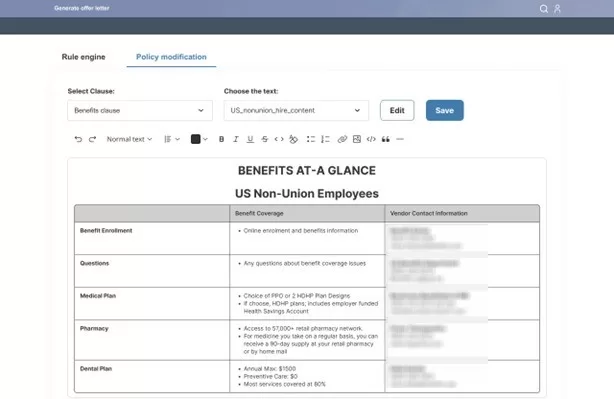Introduction
Navigating the intricacies of an effective Human Resources (HR) function can present unique challenges and demands, especially in organizations with substantial, diverse, and often seasonal workforce. Implementing an efficient HR management system is not a one-size-fits-all endeavour; it demands strategic thinking and a tailored approach. This case study showcases how SAP SuccessFactors and intelligent customization, and automation can adeptly tackle these complexities.
The Challenge
The organization in focus here faced a particular challenge with their hiring process, specifically with the generation and management of offer letters. These documents, often containing numerous conditional clauses, had become cumbersome to manage using the standard SAP SuccessFactors functionality.
With a large number of seasonal jobs on offer, the process of creating these letters manually was slow and prone to errors. It also demanded significant manpower, who dedicated their time exclusively to this task. The situation called for a solution that could streamline and automate this process, reducing both time and error margin.

To address this issue, the solution provided focused on customization and automation using SAP’s versatile platforms.
Fiori applications were developed to manage business rules and generate offer letters. These apps were designed to make the process of creating offer letters more efficient and less prone to errors by leveraging the power of automation.
Additionally, the standard SAP SuccessFactors offer letter workflow was extended using SAP SuccessFactors APIs. This extension allowed for the creation of a more complex, yet easily managed, workflow to handle the conditional clauses that had previously caused problems.
To enhance the system’s functionality further, an integration was established with SAP ECC using Odata services. This allowed data to flow seamlessly between the HR and core business systems, streamlining the overall business process.
The solution also provided a self-service interface for end users. This tool empowered them to configure offer letter clauses and manage conditions independently, creating a more efficient, user-friendly system.
Impacts and Benefits
The implementation of this solution led to significant improvements in the organization’s HR processes.
The most notable impact was the automation of the offer letter workflow. This change eliminated the need for dedicated staff to manually create offer letters, freeing up their time to focus on more strategic HR tasks. It also dramatically reduced the likelihood of errors in the offer letters, ensuring greater consistency and accuracy.
One of the most significant benefits was the decrease in time taken to generate a new offer letter. Before the solution was implemented, this process could take over 2 hours. After the changes, it was reduced to under 10 minutes – a remarkable improvement.
Conclusion
This case study exhibits the powerful capabilities of SAP SuccessFactors when coupled with strategic customization and automation.
By integrating SAP ECC and developing bespoke SAP Fiori applications, the solution not only streamlined the offer letter process but also made it more reliable. The ability to reduce the time taken for the generation of offer letters from over 2 hours to under 10 minutes underscores the immense potential of intelligently applied technology in the HR landscape.
The benefits of such a solution go beyond time and error reduction. It also bolsters the workforce by empowering them with self-service tools, thus fostering independence and efficiency. Through this case study, it is evident that SAP SuccessFactors, along with intelligent customization and automation, can facilitate transformative improvements in HR management, not just in the railway industry, but across various sectors.






